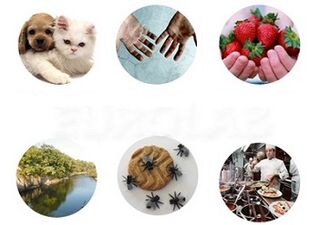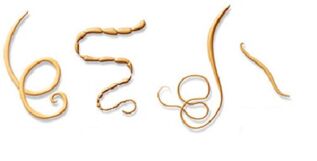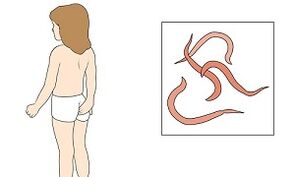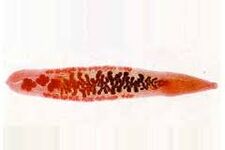Different types of parasites can stay in the human body for a long time and can cause very specific damage to health.
Many people suffer from serious diseases caused by parasites. At the same time, many have no idea about the presence of pests in the intestines and other organs.
Every type of parasite known in science has individual characteristics that an adult should know.
Infection Risk

Today, science knows more than 200 species of parasites that inhabit the human body.
Ways and means of pests penetrating the most suitable habitat have been studied in detail. We can say that each type of parasite has its own "specialization".
Most helminths live in the gastrointestinal tract. There are those that parasitize the liver, lungs and even the brain.
Almost all people are exposed to parasites. It is equally likely to be an adult or breastfed baby.
A great danger is the presence of parasites in children. First of all, it is reflected in the state of health. Babies often get sick for no reason.
There is a delay in physical and mental development. Determining the cause of the disease is not so easy, although it often "lies" in front of the eyes.
It is enough to do some research, determine the type of parasite and prescribe a course of treatment.
Many adults are at risk because their professional activities involve processing raw materials contaminated with helminths.
Some species of parasites are highly resistant to environmental influences and can be destroyed with great difficulty.
Harmful varieties
The appearance of parasites in the human body is always accompanied by certain symptoms.
The peculiarity of this situation is that the symptoms are often very mild and it is difficult to detect the presence of pests without special studies.

The following types of helminths parasitize the body:
- round;
- lent;
- fluctuates.
This classification is based on external characteristics, and parasites have many common characteristics, regardless of species.
Different shaped hooks and suction cups are designed to make it easier for parasites to position themselves in a certain place.
The life cycle of many parasites consists of several stages. Moreover, there are two "owners" of a species like a ribbon - a human and a pet.
Closed-loop migration gives these pests the ability to exist and reproduce. In the process of movement, the parasite enters the human body and feeds on it.
This feature is characteristic of all microorganisms living in the intestines or other organs. Only useful species are included in creative activities, and parasites are included in destructive activities.
Given these conditions, people need to support the benefits and bury the pests.
Round Worms
Roundworms include roundworms. It is an orange-colored and suckling parasite.
The shape of the shaft allows it to penetrate the smallest holes and wrinkles through various organs. This type of parasite is able to invade the lungs or pancreas.
Eggs laid by roundworms are protected by a strong shell that can withstand the destructive effects of hydrochloric acid in the stomach. People often get infected by eating unwashed vegetables and fruits.
Pinworm enters the human body in the same way. It is a pale gray, thin-striped worm that grows up to 10 mm in length. Already in the larval stage, the parasite begins to harm humans.

The larva, which develops into a sexually mature individual, secretes toxic enzymes that irritate the intestinal mucosa.
A mature pinworm can penetrate the deeper layers of the small intestine and penetrate inside and out. In such cases, a serious disease called peritonitis develops.
Another round parasite that parasitizes the large intestine is the whip.
The following symptoms appear when swallowed:
- headache and dizziness;
- persistent abdominal pain;
- sleep disorder.
Vlasoglav got its name from its external features - the worm is very thin and reaches a length of 50 mm. The parasite is the causative agent of trichocephalus.
The body never leaves borders - the worm can only be destroyed, after which the parasite comes out with the feces.
ribbon ribbons
The appearance of parasites in humans occurs after similar scenarios. Pork and beef tapeworms, which are in the form of black worms, enter the body when eating pork and beef contaminated by the Finns.
In appearance, these Finns or larvae are white foams and look like millet.
When it reaches the intestines, the larvae take root and begin to turn into a full-fledged parasite. Development is often asymptomatic.
After about three months, the tapeworm is able to reproduce. This type of pest is ten meters or more in length.
The presence of tapeworms in the body causes a serious teniarchinosis. A more serious threat to human health is the tapeworm parasite Echinococcus.

The human body is an intermediate home for this parasite. The main owners are animals - dogs and cats. People become infected through contact with their loved ones - by mouth.
When it reaches the intestines, the egg begins to turn into six-hooked larvae for fixation.
By the bloodstream, they are carried to various organs and are most stable in the liver and lungs.
Growing echinococcus begins to destroy the surrounding tissues. Sometimes large enough parasites are mistaken for tumors.
Alveococcus is another representative of the tapeworm parasite in the human body. After penetrating the intestine, the larvae develop intensively and penetrate the walls of the small intestine and are transported through the bloodstream to various organs and systems.
Like Echinococcus, the parasite stabilizes in the liver and begins destructive activity.
Alveococcus is a multi-chambered bladder called a larva. These larvae can invade liver tissue and metastasize to cancer.
Blood supply to the liver tissue is disrupted, necrosis begins, which poses a serious threat to human health and even life.
Fluke Worms
There is a separate type of parasite in the list of tapeworms called flukes.
The following types are especially dangerous. :
- cat mixture;
- fasciola;
- schistosome.

Liver pathologies are more common among human diseases than other organ diseases. The Flukes are named for their anatomical structures.
There are several suction cups in the body of the parasite that keep the pest in a certain place and penetrate deep into the living tissues.
The cat's wing is most common in the gallbladder and pancreatic ducts.
Fluke enters the human body with insufficiently salted or unboiled fish.
In people affected by this pest, the temperature rises sharply, an unexplained cough develops and rashes appear on the body. If you do not take immediate action, you may die.
Fasciola is absorbed into the body by drinking boiled water. Causes chronic jaundice with patient consent.
Schistosomiasis, caused by a rare parasite, has become more common in recent years.
This fact is explained by the fact that many people began to visit tropical countries where this pest is widespread.
Preventive measures
Medical experience shows that parasites take root in the intestines more than in other organs.
Different types of pests can adapt to be present in the liver, lungs, heart, brain and even the eyes - only this list gives enough information about the threat posed by parasites to human health and full life.

Different types of parasites can enter the body both individually and in combination, which increases the severity of the lesion.
To prevent all kinds of pests on your body, it is enough to follow the basic rules of food hygiene and sanitation.
Young children should be monitored regularly, especially when traveling to the country or the sea in the summer.
There is no need to eat raw meat or fish today, including sliced meat. This atavism must remain in the past forever so as not to expose your body to unreasonable risk.
















































